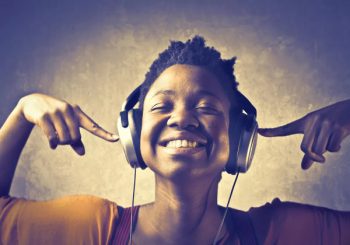Guest Writer for Wake Up World
I grew up in a very musical household, so I always think of music and community together. To me, they are interrelated and mutually supportive. Yes, they are two different aspects of wellness, and I discuss them separately below. But in practice, I find that one always leads to and complements the other: All music is a shared experience, and every community seeks to express its own voice, its own music, if you will. All music is made to be heard and shared, even if it is made and listened to alone, and no practice is better at strengthening communal bonds than sharing music together.
Plain and simple, we love music because the emotions it evokes are pleasurable. Humans are hardwired to feel pleasure, such as from food, smells, sex, touch, and sound, in the same way that we are hardwired to feel pain. Once we experience something that stimulates our pleasure receptors, we seek it out, while avoiding that which gives us pain. Music, this seemingly simple combination of sounds, harmony, rhythm, and patterns, can profoundly affect our emotional and mental state, and I would argue it is one of our very first sources of pleasure. Music is with us — soothing us, changing our moods and our emotional state — from the moment we are born, making it the quintessential sound for healing in our lives. Even in utero, fetuses can hear and react to sounds and rhythms. We know this because, after birth, babies can recognize their own mother’s voice and even music that was played during pregnancy.
Music embodies and evokes the whole range of emotions. We don’t just love happy music. We listen to music to help us release anger, feel energized, reduce frustration, invoke passion, and help us relax. In most circumstances, music helps release chemicals like dopamine, known as the feel-good chemical, while reducing stress hormones like cortisol and adrenaline.
Music has been critical to our evolution as a society and as rational, sentient beings. I don’t have to tell you that every culture, throughout the ages, has developed its own form of music that comes to define that culture and that helps bring the community together. The styles and genres we are exposed to growing up become part of our identity, as familiar as our own name. Yet music is so universal that we can learn to love and embrace all kinds and styles. Sharing different musical tastes is how we learn about one another, how we bond, and how we expand our sense of self and community.
I grew up in Puerto Rico, and for years, my grandfather, Papi Jaime, was the only music teacher in my hometown. At one point, probably every person who learned how to play guitar in Canóvanas learned from Papi Jaime. His brother, Mañeco, a sweet, dark chocolate–skinned man with a unique raspy voice — who, as of this writing, is still thriving at ninety-two years old — played the trumpet and loved my deep enthusiasm for music. Another uncle was a wonderful singer. My mom still has one of the most beautiful singing voices I’ve ever heard, a talent that sadly only gets to be enjoyed by her family and the folks at her church, but that she still expresses every chance she gets. I learned to play guitar, piano, and flute, and I sang in the university choir.
I grew up listening to my grandparents’ favorite songs: boleros from the 1940s and 1950s, which was my parents’ favorite music. We also listened to quite a lot of traditional tropical rhythms of the Spanish Caribbean: salsa, merengue, and traditional Puerto Rican seasonal music like bomba y plena. Not to mention Spanish pop artists like Menudo, Luis Miguel, Mecano, and Fiel a La Vega. In college, I was exposed to and fell in love with two very distinct musical genres: Nueva Trova (also known as “nova trova” or “protest music”) and traditional European classical music.
Beginning in the 1960s, Nueva Trova was a sociopolitical and artistic movement that evolved in Latin America to protest the foreign policy and interventionism of the United States, which supported various dictatorships and devastating economic policies. The music spoke of social change, colonialism, injustice, sexism, racism, and patriarchy, and it embodied the plight of marginalized peoples and the hope for a revolution that would lead to a better tomorrow. Even writing these words and thinking about my favorite protest songs, I feel a rush of emotions and a need to continue the hard work of speaking out for silent voices — that’s the power of music!
Meanwhile, I was invited to my very first classical music concert in college. This featured symphonic music from the Romantic period (1830–99), when European society was going through a major shift, including the industrial revolution. The concert included pieces by Chopin, Schumann, Liszt, and others. The music was so melodic and gorgeous, I spent half the concert in tears. I loved it so much, in fact, that the following semester I changed majors, stayed in college an extra year, and graduated with two degrees, in music theory and education.
We don’t have to be from a culture for that culture’s music to move and inspire us. In fact, it’s the universal power of music to help us feel that makes it healing. So when using music and sound as a wellness tool, open your heart and mind. Don’t just listen with your ears. No matter the style, genre, or sound, if music helps us feel, it can make a positive impact in our life.
Excerpted from the book from Reclaiming Wellness: Ancient Wisdom for Your Healthy, Happy, and Beautiful Life. Copyright ©2022 by Jovanka Ciares. Printed with permission from New World Library — www.newworldlibrary.com.
About the author:
 Jovanka Ciares is the author of Reclaiming Wellness and several other titles. A certified wellness expert, integrative herbalist, nutrition educator, and coach, she offers lectures and workshops in Spanish and English.. Visit her online at http://www.jovankaciares.com.
Jovanka Ciares is the author of Reclaiming Wellness and several other titles. A certified wellness expert, integrative herbalist, nutrition educator, and coach, she offers lectures and workshops in Spanish and English.. Visit her online at http://www.jovankaciares.com.

If you've ever found value in our articles, we'd greatly appreciate your support by purchasing Mindful Meditation Techniques for Kids - A Practical Guide for Adults to Empower Kids with the Gift of Inner Peace and Resilience for Life.
In the spirit of mindfulness, we encourage you to choose the paperback version. Delve into its pages away from screen glare and notifications, allowing yourself to fully immerse in the transformative practices within. The physical book enriches the learning process and serves as a tangible commitment to mindfulness, easily shared among family and friends.
Over the past few years, Wake Up World has faced significant online censorship, impacting our financial ability to stay online. Instead of soliciting donations, we're exploring win-win solutions with our readers to remain financially viable. Moving into book publishing, we hope to secure ongoing funds to continue our mission. With over 8,500 articles published in the past 13 years, we are committed to keeping our content free and accessible to everyone, without resorting to a paywall.







